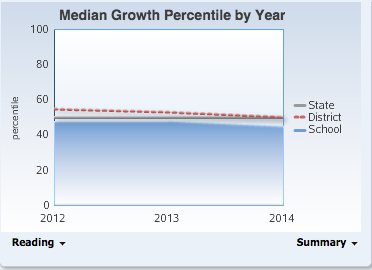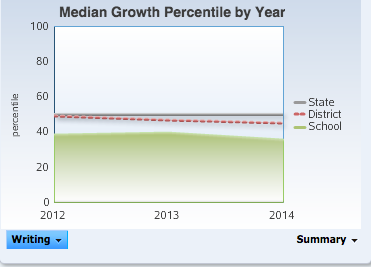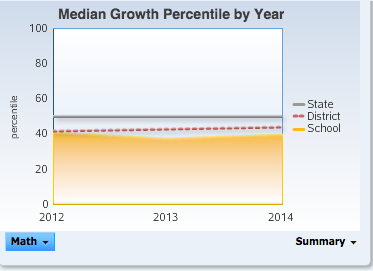Gary Rubinstein’s Blog: Open Letters To Reformers I DON’T Know. Part II: Bill Gates
Over the past three years I’ve written a series of 13 ‘open letters’ to various reformers, most were reformers “I know” as either old friends or acquaintances. When I ran out of reformers I know, I started a new series to reformers I don’t know. This is the second in that series and it is to someone who may be the most powerful person in the country driving the, I think, destructive education ‘reform’ agenda. Bill Gates was a big promoter of ‘Waiting For Superman’ and his foundation donates a lot of money to ‘reform’ minded organizations like Teach For America (full disclosure: I was a member of the 1991 TFA cohort) and various charter schools. Gates also invested heavily in the Common Core Standards and has promoted them widely.
Will I be able to use my analytic skills and my wit to win over the richest person in the world and convince him to redirect his ed ‘reform’ monster thus saving public education in this nation? You never know until you try …
1/31/2015
Dear Mr. Gates,
As a current teacher and a former computer programmer, I am concerned about the education ‘reform’ program you are currently funding. This focus on primarily measuring and fixing teachers isn’t just bad education policy. It is bad software design.
Creating a bug-free software package is not something that happens by accident. You don’t just hire a bunch of programmers and have them, unsupervised, write five million lines of spaghetti code, then without even testing it, hit ‘compile’ and ship it out to customers. No. You start with a sound plan and stable architecture. The specifications must be clear and easy to test to see if they are met. Throughout the development lifecycle, components of the product are created and tested. When these components are assembled, there is another round of robust testing to make sure that the components interface with each other properly. Good software design would include a team of experts that will surely, from time to time, disagree about the best way to make the program work. This sort of disagreement is useful since if everybody on the team always agrees, there will be an issue when one person is wrong about something, therefore everyone is wrong about something. What good is a team of ‘Yes Men’? A productive team includes people who disagree. Excluding people who are known computer experts because they are skeptical of the direction the team is taking is not going to result in a robust program. Only after the program passes all the quality review tests and the program is declared to be reasonably bug free can the product be deployed to the customers.
I spent several years as a debugger in Colorado working on the one-time giant of desktop publishing Quark XPress. I’m hoping that my abilities as a veteran teacher and also as a one time professional debugger will make you willing to listen to me when I say this current version of education reform is in need of some serious debugging. Whatever the original specifications were, maybe to raise test scores in this country?, it isn’t accomplishing that. What it is accomplishing, unfortunately, is making education worse.
I know that it has already been deployed. But just as buggy computer software can now be updated easily by downloading patches, the ed reform bulldozer you’ve created can also be fixed — but only if you’re willing to accept that it is currently not functional. Modern ed reform is the Windows ME of education. But just as you pretty quickly replaced Windows ME with Windows XP which everyone liked, you can do the same with education reform, I’m certain.
Debugging ed reform is not easy. Since it was never properly designed with a plan to ensure quality, you’ve got yourself a bug riddled mess. It was not developed modularly so it is difficult to track down where the most critical bugs are even occurring.
To me it’s very clear that the keystone of modern education reform is the belief that there are way too many ineffective teachers in this country. Many of these teachers have been flying under the radar which has prevented them from being forced to improve or forced to leave the profession. These so-called teachers have been gaming the evaluation system by putting on a show when their principals came to observe them and have then gone back to their non-teaching ways when the principal left the room. Consequently their students have not been learning very much. So a more robust evaluation system takes the human element out of the observation. A computer predicts what a student should get on the end of the year test and then the actual test result is compared to the computer prediction. If the actual score exceeds the prediction, the teacher has ‘added value’ for that student. If the prediction exceeds the actual score, the teacher has not ‘added value.’ It sounds reasonable enough.
A provision of Race To The Top is that teacher evaluations must factor in ‘student learning.’ This has come to mean, unfortunately, ‘value-added’ scores. In my analysis of actual value-added scores, I’ve found bizarre examples of teachers getting rated both positive and negative in the same year. It is like stepping on a scale and it says that I have lost 10 pounds and then moving the scale to another room and stepping on it again and learning that I have gained 10 pounds. I would hate to be the personal trainer who is being evaluated on my progress measured by this inaccurate scale.
In your 2013 Annual Letter, you wrote about how you visited a school in Eagle County School District in Colorado. You visited there, no doubt, because this was an example where the reforms you have supported seemed to be working. You wrote:
“Colorado is a pioneer in introducing these principles, and Eagle County is helping lead the way. About 10 years ago the district threw out its traditional seniority-based evaluation system and moved to a performance-based one.”
and later in the letter:
“The system is likely one reason why student test scores have improved in Eagle County over the past five years.”
You should be aware, I’m not sure if anyone has already told you, but Eagle County test scores have dropped for the past few years. Here is a graph of their math and reading scores over the past seven years.
Colorado is certainly the ‘leader’ in the country in having blind faith in faith in value-added. It counts as 50% of their teacher evaluations. Their schools are also given a value-added score, as part of the ‘Colorado Growth Model.’
It is ironic that the school in Eagle County, Eagle Valley High School, that you were so impressed by is actually lagging in their ‘growth’ scores compared to the rest of the state. They have had below average growth for the past three years in reading, writing, and mathematics. In 2014 the entire district actually had ‘growth’ below the state average in all three subjects.
Many people believe, and I think you are one of them, that ‘value-added’ does correlate with ‘student learning.’ This belief is fueled by the conclusions of the researchers that you have given money to so they can study these evaluation techniques. But what if that research is faulty? What if the researchers were not impartial scientists searching for truth? What if the researchers have let their self-interest interfere with their scientific integrity?
I do believe that you want your money to go to a good cause. This is admirable. The problem is that most of your money is going to people I’d describe as education hucksters. I’m going to be as blunt as only someone who is not on the payroll can be. In the education game you are what’s known as a ‘fat-cat,’ a ‘mark,’ a sucker.
You are like the Emperor who was swindled into purchasing non-existent clothes. But that Emperor was brought back to reality when a blunt child said what everyone else what thinking. In ed reform it is blunt experienced teachers who are willing to say the obvious.
Your researchers are making a lot of money off of your trust. And in doing so they are misinforming the politicians who use this research as justification for reckless reforms that are nearly guaranteed to have negative side effects that undermine any good that may have existed in them. This is what happens when the project manager is not familiar with the terrain and you, Mr. Gates, are that uninformed project manager.
When it comes to education reform, your investment strategy was unnecessarily risky. You are like an investor who has put all his money into Blue Chip stocks. You need to diversify your portfolio. I think to you it seems like you are already doing this but I believe if you were to take an honest look at where your money is flowing, about 99% of it is toward the ‘side’ that believes that fixing teachers will fix education, and the best way to fix teachers is to evaluate them through the ‘value’ that a computer believes they ‘added’ to their students’ standardized test scores.
The effects of your investment in defective education reform is growing exponentially as the biased research you fund is now being quoted by politicians to advance their own uninformed opinions which were likely guided by previous biased research. An example of this is in New York where we’ve had a teacher evaluation fiasco over the past few years. Every district had to have their plan to include ‘student achievement’ into the teacher evaluation meaning, of course, value-added. So they did this and all the districts got their plans approved by former education commissioner John King (who now is a senior advisor to Arne Duncan). The New York City department of education and the union could not agree on a plan so they agreed to accept whatever John King imposed, which was 20% value-added. Well, not enough teachers got poor ratings for the Governor’s liking so now he wants the value-added to be increased to 50%. Where did he get the idea that 50% was an appropriate amount? Perhaps from one of the research reports that you funded by the value-added ‘guru’ Thomas Kane, who suggested it be somewhere between 33% and 50%.
Raising the percent of value-added to teacher evaluations has not been shown to improve test scores. Even Kane’s research hasn’t claimed that it has. All the research says is that it is more consistent than some critics contend. But if the point is that it should increase test scores, it is certainly time to study why it fails to do it and whether or not is is worth all the money that goes into annual testing and into proprietary value-added formulas, not to mention all the time spent on mindless test prep and the loss of time for things like music and art, whether this is a cost efficient and effective way to raise test scores. My sense is that it is a resource Black Hole.
Here’s an analogy that you can relate to: Imagine some very powerful person decided one day that PC computers running Windows are ‘failing.’ They crash once every two weeks. They get various types of viruses — adware, spyware, things like that — which gum up the operating system, slowing down performance. This powerful person proposes that Windows should crash no more than once a year and it should never get unwanted viruses. As a computer expert, you would say that this is an unrealistic expectation. Though there are systems that are ‘crash proof’ — like something that controls nuclear missiles — these systems are very costly. So you say that you can make a Windows that only crashes once a year, but it will have to cost more and they say that throwing money at the problem is not the answer. You propose a virus scan, but they say that virus scans slow down the performance of the system. They want a virus scan that does not run in the background all the time. You say that, by definition, a virus scan has to run in the background all the time. They say that you are just a naysayer and they will shut down Microsoft and instead hire a more optimistic team. And they have no trouble finding a team who knows little about computers but promises to meet the new specifications without going over budget. But you know that they will fail and it is frustrating to watch all that wasted time and money which could have been used to truly improve Windows.
You say that spending on education has risen while test scores have not so spending isn’t the answer. I don’t know about that. If I want to lose 20 pounds and my exercise regimen is to work out once a month and then I ‘double’ it to twice a month, would any fitness expert expect my results to be much different? Maybe doubling isn’t enough. Maybe to get the test scores you want, spending has to increase by a hundred-fold. For the sake of testing the hypotheses that more money doesn’t lead to higher test scores, I think you are spreading your money too thin. A million to this district, ten million to that one. Why not just take a supposedly failing school somewhere like Detroit and see what can be done with a hundred million dollars? Maybe each student has his or her own personal trainer making $75,000 a year to do nothing but help that kid. This trainer makes sure that the kid eats well and gets enough sleep. If the kid is prescribed medication, the trainer makes sure it is taken. Class sizes in this school during the time of the experiment can have a maximum of 8 students. The school is provided with every possible amenity. Rather than replace all the teachers, use the money to get the most out of the teachers that are there. If class size is capped at 8, each teacher has a pretty small class load, even if this is a middle school. The teachers will have more time to dedicate to each student as well. The school would have plenty of guidance counselors, social workers, and nurses. Students can learn more than just math and reading, but also get the opportunity to paint, do drama, and play a musical instrument.
If test scores go up sufficiently at this school, try the experiment again at another school, but this time give them just fifty million dollars. If that works, give the next school twenty-five million dollars. In O(lg n) iterations you would find out what the ideal amount of money is to get test scores sufficiently high.
Over the past few years I’ve seen signs that you ‘get it.’ You wrote an op-ed against publishing teacher value-added scores in the newspapers. In contrast to the over-confidence of many charter school zealots, you recently said in an interview “It would be great if our education stuff worked, but that we won’t know for probably a decade.” I also saw that you admitted that technology in education doesn’t work so well for unmotivated students. Your foundation recommended against using common core tests in teacher evaluations for the next two years. These admissions have not really slowed down the ed reform steamroller you have put into motion, but if your foundation can continue to make these sorts of admissions, it will help.
It is not too late to correct the course of this disaster you’ve commissioned. The first thing I’d do if I were you is demand that the researchers who have created all the papers that support the usefulness of value-added to release all the raw data from which they formed their conclusions. This way other researchers can crunch the exact same numbers and see if they can find alternative theories based on that same data. Then the two conflicting groups can publicly debate their conclusions.
There are a lot of organizations that you could donate some money to which would help counter the one-sided education reform agenda you have been advancing. Network For Public Education and Class Size Matters come to mind. You could also support some great bloggers who have been blogging on their spare time for free all these years. Here’s what you do: Go ‘Bing’ the word ‘Google’ and then Google the names Anthony Cody or Bruce Baker or Mercedes Schneider or Jose Vilson or Mark Weber (A.K.A. ‘Jersey Jazzman’) or Jennifer Berkshire (A.K.A. ‘EduShyster’) for a few examples.
Sincerely,
Gary Rubinstein
Math Teacher
New York City
This blog post has been shared by permission from the author.
Readers wishing to comment on the content are encouraged to do so via the link to the original post.
Find the original post here:
The views expressed by the blogger are not necessarily those of NEPC.






